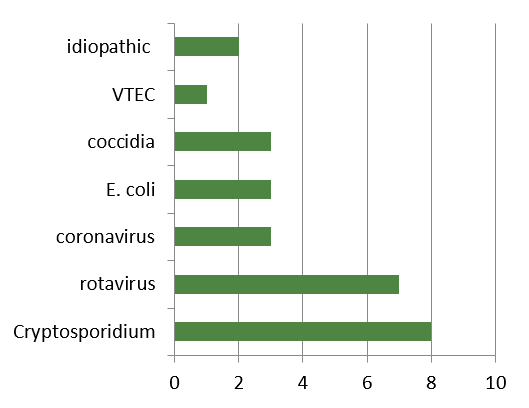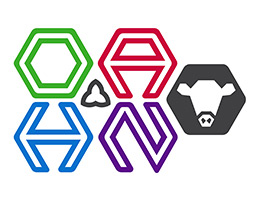Ontario Animal Health Network (OAHN) Bovine Expert Network Quarterly Veterinary Report
OAHN Q2 Laboratory Data from the Animal Health Laboratory
There were 144 bovine pathology submissions between May 1 and July 31, 2020.

Yew toxicosis
The sudden death of a 5 month-old beef heifer was diagnosed as yew poisoning when the herd veterinarian detected the characteristic foliage in the rumen content at postmortem. In total 3 animals died and another 6 became sick. Yew toxicosis is one of the few toxicoses that can be diagnosed at gross PM.
Alimentary diseases

Enteritis was the most frequent pathology diagnoses among calf submissions under 2 months of age (See Figure 2 for etiologies). There were 3 enteritis diagnoses in cattle between 2 mo and 2 years of age.
In adult cattle (>2 years) there was a single diagnoses of jejunal hemorrhage syndrome, consistent with the number in previous quarters.
Abortion
There were 28 submissions for abortion investigations (dairy n=14, beef n=2, commodity unreported n=12). The infectious causes of abortion identified were bacterial (n=6, including Streptococcus sp., E. coli, and
Trueperella pyogenes), Ureaplasma (n=3), and Neospora (n=2).
Salmonella Dublin
Salmonella Dublin was isolated on bacterial culture from 8 submissions representing 2 unique premises.
Bovine Viral Diarrhea Virus
A total of 203 BVD PCR tests were conducted in Q2 of which 7 were positive.
Disease testing in newly introduced cattle –OAHN Project OPEN for submissions
Project Overview
The introduction of new cattle into a herd is a significant risk factor for the introduction of disease. An important action to prevent the introduction of disease is evaluation and testing of new cattle prior to purchase. For many diseases, infected cattle will show no signs of illness and can be better or only detected by diagnostic laboratory test.
A new OAHN project has been launched to facilitate the testing of purchased cattle. The OAHN project will provide a panel of testing for recently purchased cattle at no cost. The tests in the panel includes Anaplasmosis, Bovine leukosis, Johnes, and Salmonella Dublin. See Page 3 for descriptions of each of these diseases.
How to Participate
Any beef or dairy producer in Ontario with cattle 2 years or older purchased in the previous 365 days is eligible to participate. Contact your herd veterinarian to have blood samples collected and submitted to the Animal Health Laboratory in Guelph. By using the OAHN project submission form, the lab test costs will be covered by the project.
Results will be delivered directly back to the submitting veterinarian to interpret and discuss with their client.
Why should I participate?
- Disease test results allow producers to make informed farm management and biosecurity decisions to protect their herd.
- Testing cattle that are for sale in Ontario will allow OAHN to increase surveillance for two emerging diseases, Salmonella Dublin and Anaplasmosis among a higher risk population.
Important Notes:
The project covers lab testing costs but there may still be fees associated with collection of blood samples by your veterinarian or technician. Talk to you herd veterinarian to determine these costs.
Salmonella Dublin and Anaplasmosis are included in the list of immediately notifiable diseases under the Animal Health Act in Ontario and positive results are automatically reported to OMAFRA.
What diseases will the OAHN Bovine project test for?
- Anaplasmosis – An infectious bacterial disease caused by Anaplasma marginale that infects cattle red blood cells causing anemia. The disease is most severe in animals above 1 year of age and can be fatal. Recovered animals become carriers of the disease which can be transferred to uninfected animals by ticks, biting flies, and the use of shared equipment such as needles. The disease is wide-spread in the United States and has been detected rarely in Ontario.
- Bovine leukosis – A viral disease in cattle caused by bovine leukemia virus. Infected cattle have reduced milk production and about 5% of infected cattle develop tumours.
- Mycobacterium avium paratuberculosis (Johnes) – A contagious, progressive bacterial infection of the digestive tract eventually causing diarrhea and weight-loss. Infected animals can shed the bacteria in their feces with no other signs of infection, putting healthy herdmates at risk.
- Salmonella Dublin – A multi-drug resistant bacterial disease that causes severe outbreaks of pneumonia and septicaemia with high mortality in calves. Mature cattle may develop illness or abort pregnancies. Recovered animals can become carriers of the disease and periodically shed the bacteria in feces or other fluids without appearing sick. This disease is zoonotic, meaning people can also become infected from contact with infected animals or consuming infected food products including raw milk.
The OAHN project uses ELISA tests to detect infected cattle which look for antibodies – evidence that the animal has experienced infection from the disease of interest. Talk to your herd veterinarian to get more information on these diseases or other cattle diseases of risk to your herd.


